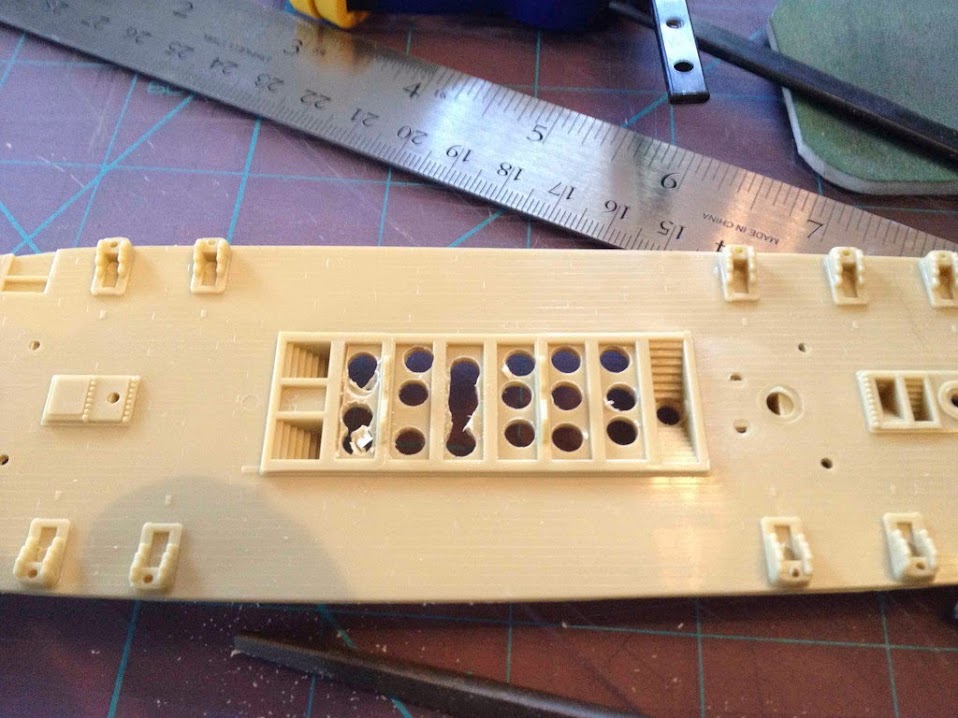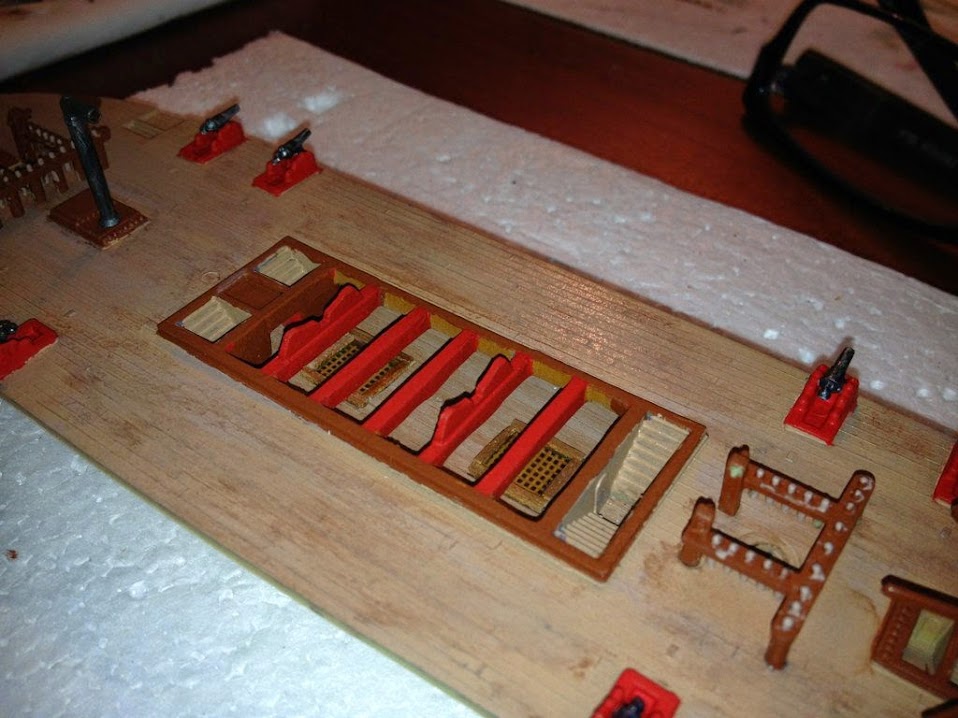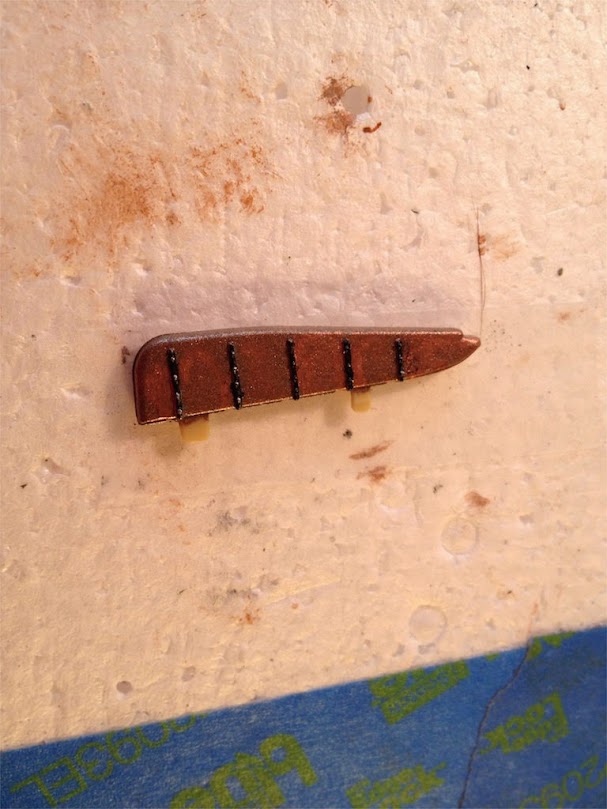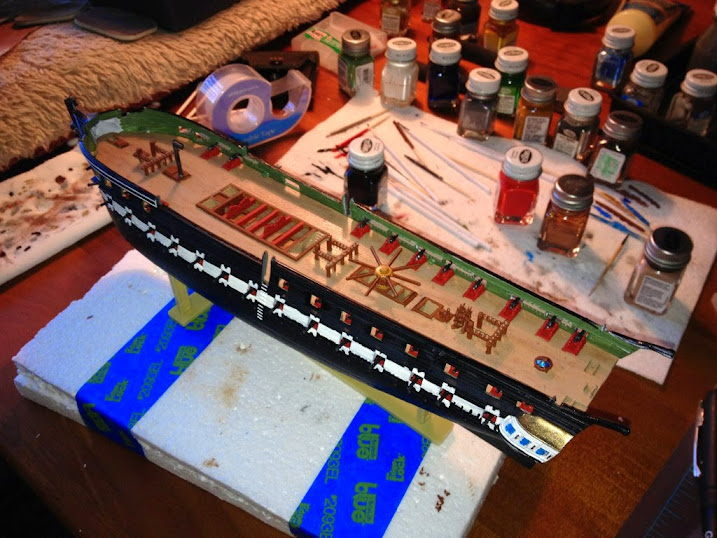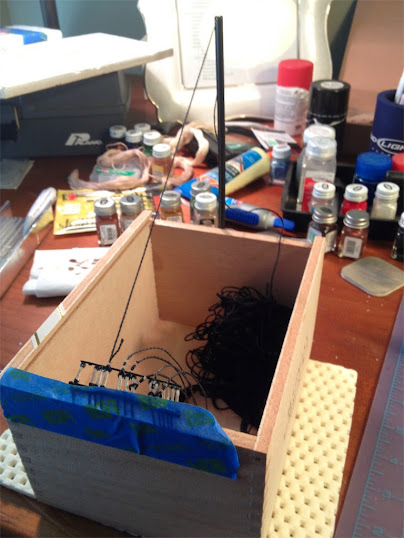This is shaping up into a nice model. If this is your first serious effort, I’m sure we’ll all look forward to seeing the next one.
I don’t know how interested you may be in the history of the kit, but it’s a real classic. It was originally released in 1956, as one of Revell’s first two sailing ship kits. (The other was H.M.S.Bounty.) It represented the state of the art at the time, and it still holds up remarkably well.
One big problem confronting all modelers of the Constitution is the fact that the ship has been modified so many times over the years. The 1/196 (or 1/192; different sources list it differently) version apparently was based on the set of plans the Navy published at the time of her major restoration in the 1920s. The Navy researchers weren’t trying to backdate her to a particular period. She still looked about like that in 1956. Since those days the philosophy has changed; for the past thirty years or so they’ve been trying, as they get the money, to bring her back to her War of 1812 configuration. There are quite a few differences between the kit and the way she looks now.
The one thing Revell changed from her 1956 configuration, I believe, was the figurehead. From the late nineteenth century onward she had a relatively simple “billet head,” as she has today. She had a similar decoration on her bow for much of the War of 1812. In the 1830s she was fitted with the Andrew Jackson figurehead that’s reproduced in the Revell kit.
That Jackson figurehead has an interesting history of its own. In case you haven’t heard it, here’s a summary from a Forum post I wrote in 2008:
"Regarding the sad story of the Constitution and her Andrew Jackson figureheads - the most thorough account of the incident I’ve encountered is in one of the books I assign in my freshman-level U.S. history survey course: Andrew Jackson: Symbol for an Age, by John William Ward. He analyzes the ‘Jackson image’ and where it fit into the typical American’s perception of what his country was about.
"The Constitution went into the Boston Navy Yard for an overhaul in 1833. The commandant of the yard was Captain Jesse Elliot, one of the Navy’s more controversial characters. (He was, among other things, the officer who, in command of the Niagara, had so irritated Oliver Hazard Perry during the Battle of Lake Erie that Perry had transferred his flag to her in order to bring her into the fight. That, at least, is how Elliot’s numerous critics told the story.) Her figurehead was in bad shape, and Elliot, a Jacksonian Democrat, thought it would be appropriate to install a portrait of Jackson as a replacement.
"While the figurehead was being carved, Jackson pulled one of his more memorable and controversial stunts: he got into a titanic war with the Bank of the United States and pulled the federal government’s funds out of it, thereby precipitating a national financial panic. At that point, as Professor Ward puts it, ‘even those who had been able to find kind words for the President because of his Nullification Proclamation [against John C. Calhoun and the South Carolina Legislature] relapsed into the customary New England habit of vituperating the tyrant in the White House.’ Boston newspapers launched attacks on the idea of putting Jackson on the bow of the city’s favorite frigate, and Elliot was threatened with tar and feathers.
"The figurehead was completed and installed. Then, on the night of July 2, 1834, somebody, in the middle of a noisy rainstorm, sawed the head off it. The culprit was never caught; the Constitution sailed for New York, where she was fitted with a new figure of Jackson. (Until the new one was ready, Elliot had a flag with five stripes on it draped over the mutilated one - symbolizing the five New England states that had threatened to secede from the Union during the War of 1812.)
"The story of what happened afterward gets pretty amusing - and, as Ward puts it, the severed head gets ‘ubiquitous.’ Several accounts of dubious reliability identify the perpetrator as a Cape Cod sea captain named Dewey. One source says he walked into the White House and presented the head to Jackson, who glared at him for a minute and then said, ‘close the door, Captain Dewey, and then sit down and tell me how you did it.’ Another says Dewey gave the head to the Secretary of the Navy, who passed it on to Jackson, who reacted by saying: ‘Make that man a postmaster.’ Yet another says that somebody or other arrested Captain Dewey and locked him in a local insane asylum for two and a half months. Dewey supposedly had somebody make him a box of business cards, each bearing a picture of a saw and the words ‘I came, I saw, I conquered.’ Unfortunately the existence of Captain Dewey isn’t confirmed by any reliable contemporary source.
My favorite version of the aftermath comes from the pen of somebody named Russell Jarvis, who published a short biography of Captain Elliot. Jarvis (quoted by Professor Ward) says that Nicholas Biddle, the president of the Bank of the United States, paid a visit to Boston shortly after the beheading. ‘While he [Biddle] was there…some of the most leading, the most active “Whig” [i.e., anti-Jackson] politicians, particularly those connected with the monied institution, to the number of forty-four, invited him to an evening entertainment at one of the Boston coffee-houses. After the cloth was removed [i.e., after dinner, when it was time for the serious drinking to start], the servants were sent from the room, the doors locked, and, – Bostonians! blush while the revolting story is told! THE HEAD OF THE IMAGE WAS BROUGHT IN, LAID UPON THE TABLE AND BACCHANALIAN ORGIES WERE HELD OVER IT!!!’
“It sticks in my head that one of the two Jackson figureheads is (or used to be ) in the Naval Academy Museum and the other in the Museum of the City of New York. That’s my notoriously unreliable memory talking, though. I couldn’t find any mention of them on either museum’s website.”
The bigger, 1/96-scale Revell kit first appeared in 1965. (My source for the dates is Thomas Graham’s fascinating book, Remembering Revell Model Kits.) This one is based on a set of plans that were commissioned shortly before that by the Smithsonian, to represent the ship as she appeared in 1814. There are questions about some of the details on it, but generally it represents that configuration pretty accurately. (At least two Forum threads about it are running right now.) The two kits make an interesting comparison.
We’ll all be interested in seeing how this fine model develops. Welcome aboard! You’ll find that the “Ships” Forum is inhabited by some pretty strange people, but most of us are relatively harmless.
